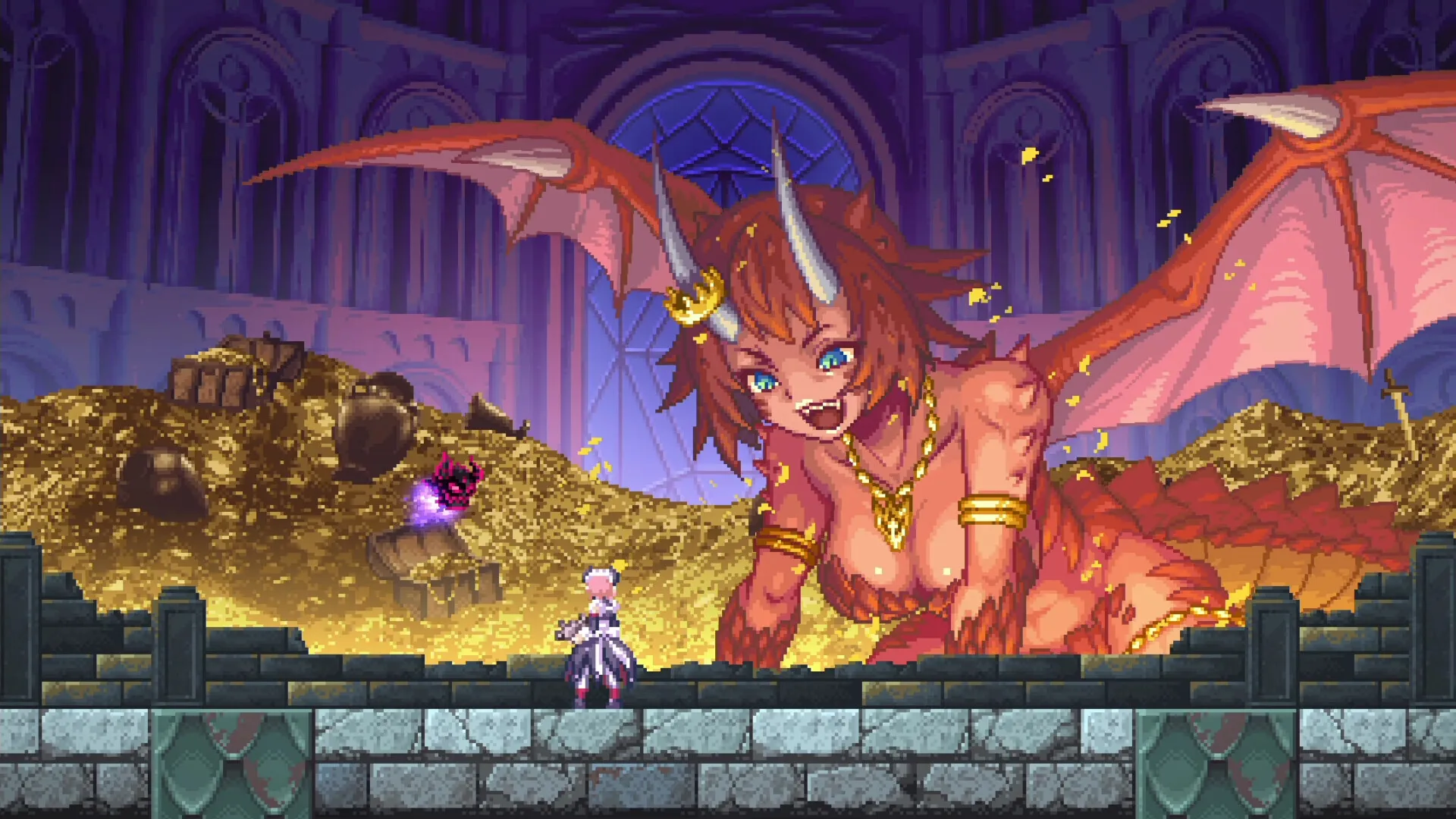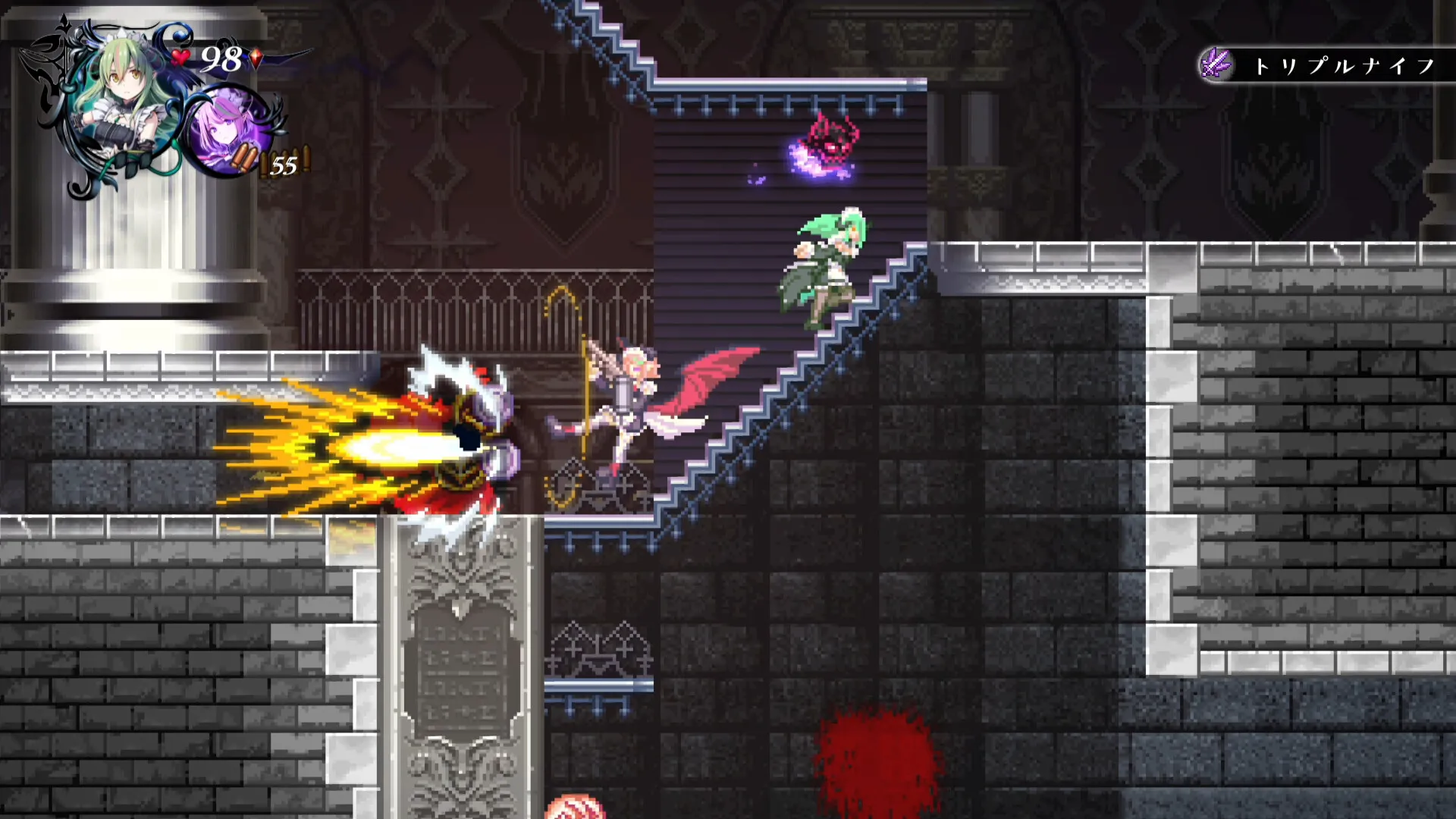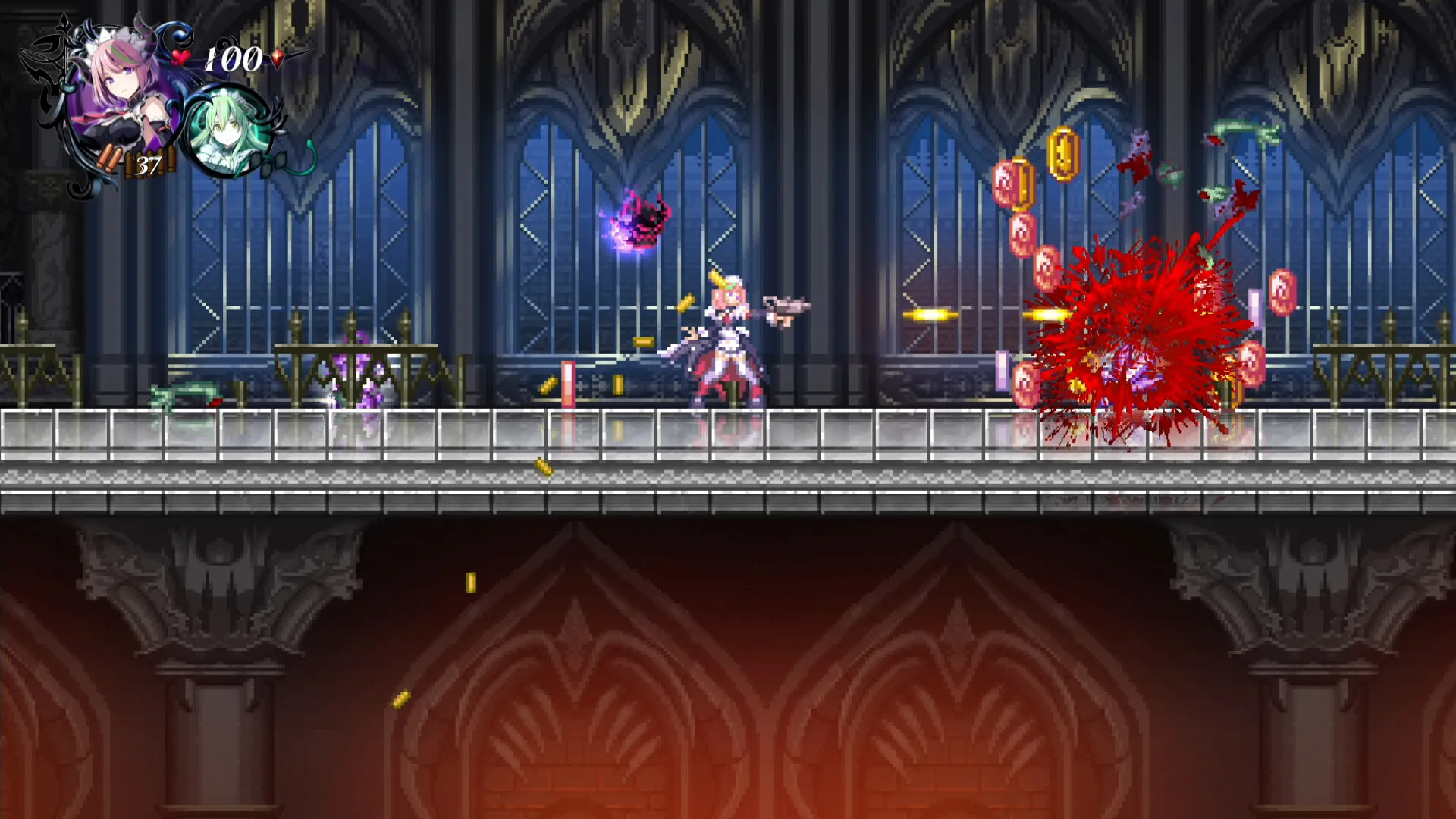Gal Guardians: Servants of the Dark emerges as a 2D metroidvania action-adventure defined by its pixel art style and influences drawn from Japanese animation. The narrative follows two demon maids returning from vacation, only to find their master’s castle overtaken by forces that have upturned the established order. Set in a world segmented into the demon, human, and heaven realms, the game presents a stage where supernatural conflict and everyday humor coexist.
The central mission centers on restoring Demon Lord Maxim’s fragmented form through the retrieval of his scattered bones. This task is woven into the mechanics of exploration and combat, where each encounter and every hidden pathway contributes both to character progression and narrative advancement.
Players control two protagonists, each with distinct fighting techniques—one wielding firearms from a distance and the other engaging in close combat with a whip. This setup not only offers variety in gameplay strategy but also mirrors storytelling traditions found in regional anime, where character roles are sharply defined yet interdependent.
Appealing to enthusiasts of classic metroidvania action and fans appreciative of character-driven storytelling, the game resonates with an international audience. It reflects elements common in Japanese cultural production while opening a dialogue with global cinematic and interactive narrative practices, inviting players to experience a familiar tale reinterpreted through diverse cultural filters.
Narrative Complexity: A Cultural Crossroads
The game opens with a castle under siege in a realm where ancient traditions meet modern gaming sensibilities. The storyline centers on the struggle to rebuild a mighty demon lord by gathering scattered bones—a task that transforms into a quest for reassembling not only a character but also the pride of a shattered order. Within the castle’s walls, internal strife surfaces as rival demon factions clash and treachery unfolds among its inhabitants, provoking questions about loyalty and betrayal that feel familiar across different cultures.
The setting unfolds over three distinct regions: a chaotic demon world, a realm of humans, and a higher plane of angels. The demon realm, serving as the primary arena for conflict, is partitioned into varied environments such as eerie forests, treacherous dungeons, icy corridors, and fiery battlegrounds. This segmentation offers rich scenery for exploration and puzzle-solving, where each zone echoes specific regional influences seen in diverse storytelling traditions worldwide.
Character development is pronounced through the clear contrast between the two protagonists. Kirika, who relies on her precise firearms skills and rapid-fire techniques, represents a calculated, distance-based method of engagement that mirrors modern tactical narratives found in global cinema. Masha, wielding a whip and harnessing elemental charges, embodies a hands-on approach to conflict that carries echoes of legendary martial tales.
Meanwhile, Maxim’s transformation—from a full-fledged demon lord to a diminished yet symbolically potent floating skull—serves as a narrative device where recovery and empowerment occur through both combat and careful resource management. His evolving support role, enhanced by equipment upgrades, underscores the interconnection between story progression and gameplay.
Humor and personality infuse the dialogue and interactions, with quirky designs and animated banter adding light moments amidst the darker, reflective themes of revenge and redemption. The act of collecting bones merges directly with leveling up and unlocking new abilities, making the unfolding narrative inseparable from the player’s evolving experience.
Gameplay Dynamics and Combat Innovation
The game features a fluid system that allows players to alternate between two distinct characters. Kirika and Masha each offer their own playstyle with individual health pools and tailored attack methods. The option to revive a fallen sister in the midst of battle grants a tactical edge that transforms challenging encounters into opportunities for coordinated play. This switching mechanic creates a layer of strategy that resonates with interactive experiences found in global gaming traditions.
Gunplay is at the heart of Kirika’s approach. Her rapid-fire sequences and burst-fire dashes create a tempo that contrasts sharply with Masha’s measured melee strikes. Masha’s use of a whip for close combat, combined with charged attacks that add elemental effects or extra force, provides a counterbalance to Kirika’s style.
The distinct approaches push players to consider situational tactics. For example, initiating a fight from distance with Kirika’s automatic fire and switching to Masha’s close-range attacks when enemies draw near creates rhythmic moments that mirror techniques seen in classic action narratives.
The combat system expands through a layered weapon structure. Each character’s fixed primary weapon sets the stage for dynamic skirmishes, while a diverse array of secondary items further alters the flow of fights. These sub-weapons, organized by compatibility with one or both characters, adjust combat attributes such as damage intensity, reload speed, and special effects.
Experimenting with various builds is central to maximizing effectiveness in battle. Collecting Maxim’s bones fuels a leveling network that raises health, attack strength, and energy reserves. This progression unlocks additional skills that add finesse to executing combo moves, whether through dash maneuvers or quick counterattacks.
Different game difficulty settings modify factors like enemy hit points and damage output, offering experiences that suit both newcomers and veteran players. Such configurable challenges ensure that tactical ingenuity and fast reflexes are rewarded, making each encounter a test of skill and adaptability.
Architectural Evolution and Spatial Storytelling
Maxim’s Castle serves as the central hub, a living structure that transforms as players collect Maxim’s bones and trigger new upgrades. As the hub expands, new corridors and modules appear, introducing additional characters and facilities that enhance the game’s interactive experience. The castle’s evolving state mirrors historic fortresses that have been reshaped by time and conflict, reflecting local artistic traditions with a modern interactive twist.
The game arranges several themed regions—wooded groves, shadowed dungeons, ice-bound passages, and burning battlegrounds—each offering its own set of obstacles and adversaries. The background incorporates intricate details that hint at cultural folklore, while the foreground stages the primary conflicts with clarity. These visual arrangements remind one of classic pixel art found in international productions, where visual storytelling and gameplay intersect to express identity and heritage.
Players rely on an in-game map to locate key objects, non-player figures, and areas for improvements. Fast travel options exist but are infrequent, prompting repeated returns to the hub. Hidden rooms and compact passageways with puzzle elements challenge players to explore every corner, rewarding persistent attention with access to secret upgrades or shortcut routes.
This cycle of returning and rediscovering provides a measurable progression that informs both narrative and mechanical advancement. The overall design creates a space where practical progression intertwines with artistic expression, prompting reflection on how digital realms mirror ritualistic exploration seen in various cultural traditions.
Aesthetic Resonance and Auditory Craftsmanship
The detailed pixel art style of the game sparks discussion on cultural craftsmanship across media. The backgrounds demonstrate careful attention to depth, establishing layers that support a distinct visual narrative. Characters show clear influences from Japanese animation; their designs feature lively color schemes and expressive motion that suit the dark, playful theme. Each frame appears meticulously crafted, reflecting both traditional techniques and modern technology in digital art.
The musical score contributes significantly to the game’s identity. A collection of sounds set in eerie dungeons and rhythmic tunes during combat serve as a bridge between visual storytelling and interactive performance. The Japanese voice acting, paired with precise subtitles, provides a level of authenticity reminiscent of internationally recognized anime projects. Sound effects—sharp slashes, crisp gunfire, and impactful explosions—create an immediate sensory connection with the action, turning every encounter into a multisensory experience.
User interface elements are clear and responsive. Indicators for weapon modifications, health displays, and map annotations appear straightforward during both fights and exploration. These components help the player focus on the moment-to-moment engagement, ensuring that the presentation both guides and enriches the overall interactive expression.
Synergistic Play and Evolving Engagement
The cooperative mode introduces a dynamic where two players control Kirika and Masha simultaneously, merging distinct fighting techniques into a unified tactical display. Local play offers a shared screen experience, while an online option brings global partners into the fold, each contributing their style to puzzles and combat. A feature that permits one character to serve as a physical boost for the other during platform challenges stands out—a playful nod to cooperative innovation observed in international gaming titles.
Team coordination becomes essential as characters utilize abilities complementarily. For instance, one character’s capacity to restore the other amid a concentrated assault transforms potential setbacks into collaborative triumphs. Similarly, combining sub-weapon effects can alter enemy engagements, highlighting the duality between individual prowess and collective strategy. This interplay reflects cultural influences spanning traditional cooperative gameplay from both Eastern and Western markets.
Progression in the game is tied to a distinctive bone collection mechanism, where restoring Maxim’s strength directly influences the protagonists’ capabilities. The system demands a careful exchange of gathered resources at the central hub, a process balanced against the challenge of extensive exploration and periodic revisits to familiar territories. An in-game craftsman, responsible for enhancing sub-weapon features, reinforces a theme of customization that invites repeated experimentation.
The presence of additional quests and side objectives, including efforts to reinstate fallen non-player characters, contributes to a layered sense of replayability. Certain aspects of inventory management and move combinations require time to master, a factor that may both test and reward long-term engagement.
The Review
Gal Guardians Servants of the Dark
Gal Guardians: Servants of the Dark delivers a fulfilling mix of tactical gameplay and intricately styled visuals, complemented by a layered narrative that reflects its cultural roots. The cooperative mechanics and versatile combat encourage exploration and experimentation, enhancing the player’s connection to both character and setting. While certain aspects of inventory management and progression require refinement, the game succeeds in appealing to metroidvania enthusiasts and action-adventure fans alike.
PROS
- Innovative dual-character switching enhances tactical depth.
- Engaging cooperative mode fosters team-based gameplay.
- Detailed pixel art and expressive character animations.
- Unique leveling and weapon customization system tied to narrative progression.
- Rich, culturally influenced design and sound direction.
CONS
- Inventory management can feel cumbersome.
- Fast travel options are limited, leading to frequent backtracking.
- Learning complex move combinations may challenge some players.




















































